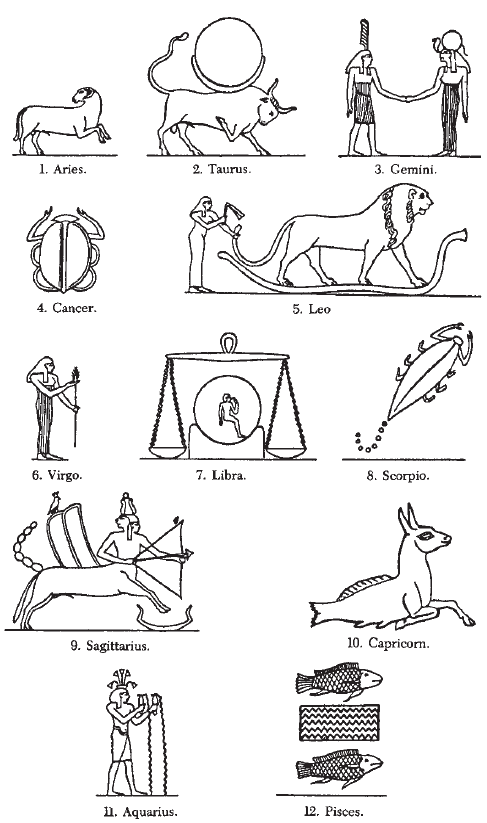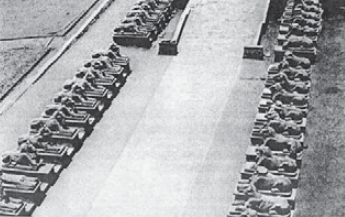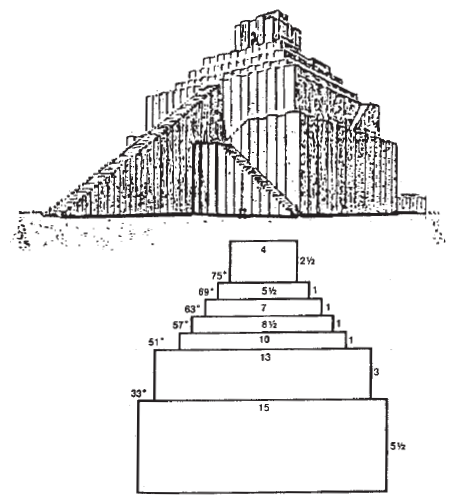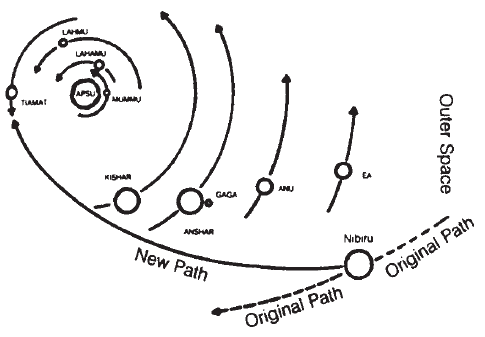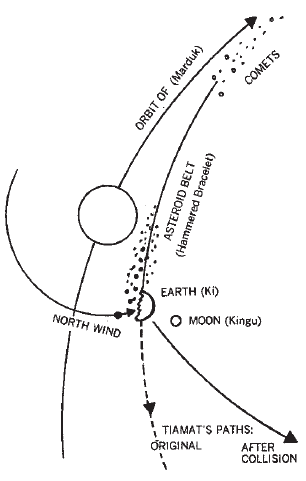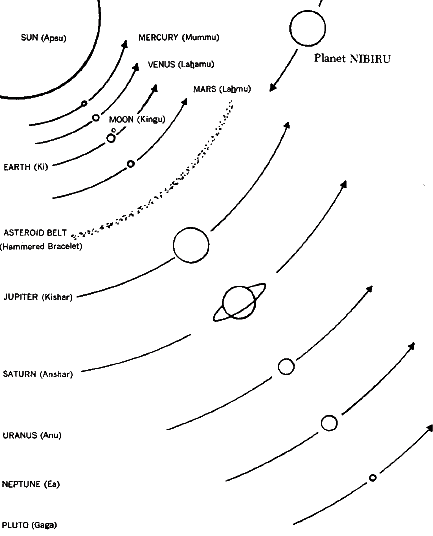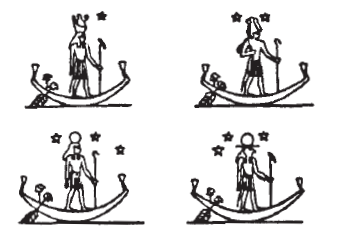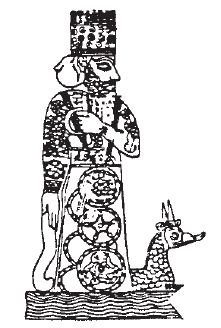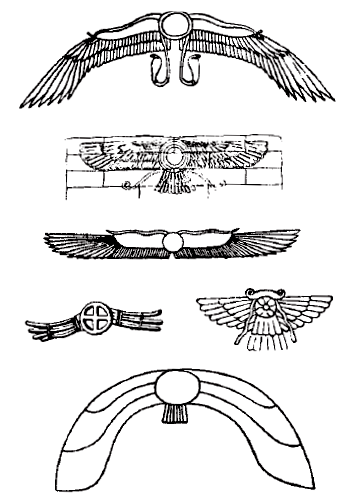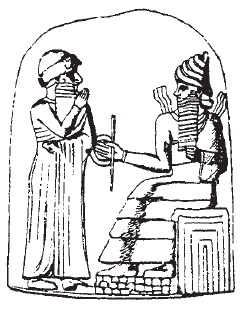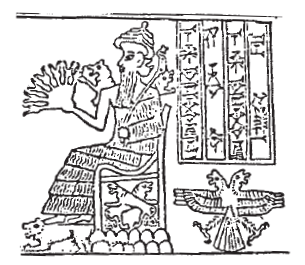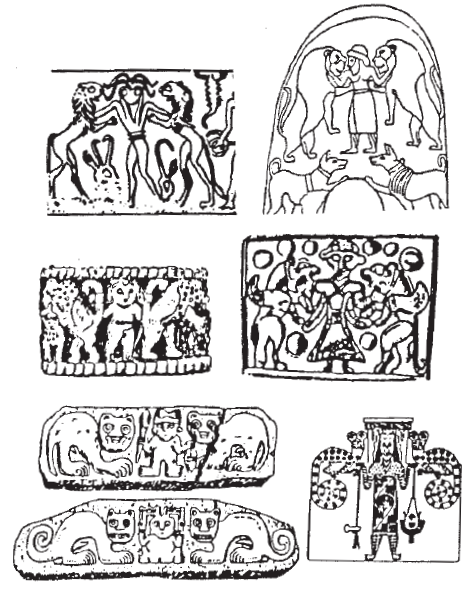|
DESTINY HAD FIFTY NAMES
It
was, in almost all respects, truly a New Age, even the way we
understand the term nowadays. Its greatest paradox was that while it
made Man look to the heavens, it brought the gods of the heavens
down to Earth. The changes that New Age has wrought affect us to
this day.
Lists of zodiacal constellations began not with the Bull as in Sumer, but with the Ram (Fig. 38).
The most impressive manifestations were the rows of Ram-headed sphinxes that flanked the processional way to the great temples in Karnak (Fig. 39), whose construction, by Pharaohs of the newly established Middle Kingdom, began right after Ra/Marduk’s ascent to supremacy.
Figure 38
They were Pharaohs who bore theophoric
names honoring Amon/Amen, so that both temples and kings were
dedicated to Marduk/Ra as Amon, The Unseen, for Marduk, absenting
himself from Egypt, selected Babylon in Mesopotamia to be his
Eternal City.
His veneration both there and in Mesopotamia is attested to by
sacred places named in his honor—such as Mount Nebo near the Jordan
River (where Moses later died)—and the theophoric royal names (such
as Nabo-pol-assar, Nebo-chadnezzar, and many others) by which famous
kings of Babylon were called. And his name, as we have noted, became
synonymous with “prophet” and prophecy throughout the ancient Near
East.
In his autobiographical text The Marduk Prophecy he envisioned the coming of a Messianic Time, when gods and men will recognize his supremacy, when peace shall replace war and abundance will banish suffering, when a king of his choice “will make Babylon the foremost” with the Esagil temple (as its name meant) raising its head to heaven:
That new Tower of Babel, however, was not intended (as the first one
was) as a launch tower. His supremacy, Marduk recognized, was now
stemming not only from the possession of a physical space connection
but from the Signs of Heaven—from the zodiacal Celestial Time, from
the position and movement of the celestial bodies, the Kakkabu
(stars/planets) of heaven.
Figure 40 But the gods’ planet, Nibiru, was still orbiting and clocking Divine Time—and Marduk’s attention shifted to that.
As his Prophecy text made clear, he now envisioned astronomer-priests scanning the skies from the ziggurat’s stages for “The rightful planet of the Esagil”:
A Star-Religion was born. The god—Marduk—became a star; a star (we
call it planet)—Nibiru—became “Marduk.” Religion became Astronomy,
Astronomy became Astrology.
Written in “Babylonian,” a dialect of Akkadian (the Semitic mother language), it equated Marduk with Nibiru, the home planet of the Anunnaki, and gave the name “Marduk” to the Great Star/Planet that had come from deep space to avenge both the celestial Ea and the one on Earth (Fig. 41).
Figure 41
It thus made “Marduk”
the “Lord” in Heaven as on Earth. His Destiny—in the heavens, his
orbit—was the greatest of all the celestial gods (the other planets)
(see Fig. 1); paralleling that, he was destined to be the greatest
of the Anunnaki gods on Earth.
It credited Marduk with the defeat of the “monster” Tiamat in the Celestial Battle, the creation of the Earth (Fig. 42), and the reshaping of the Solar system (Fig. 43)—all the feats that in the original Sumerian version were attributed to the planet Nibiru as part of a sophisticated scientific cosmogony.
Figure 43
The new version then credited Marduk even with the “artful fashioning” of “Man,” with devising the
calendar, and with the selection of Babylon to be the “Navel of the
Earth.”
It was conducted according
to elaborately defined ceremonies and prescribed rituals that
reenacted (in Sumer) the tale of Nibiru and the coming of the
Anunnaki to Earth, as well as (in Babylon) the life story of Marduk.
It included episodes from the Pyramid Wars, when he was sentenced to die in a sealed tomb, and his “resurrection” when he was brought out of it alive; his exile to become the Unseen; and his final victorious Return.
Processions, comings and goings,
appearances and disappearances, and even passion plays with actors
visually and vividly presented Marduk to the people as a suffering
god—suffering on Earth but finally victorious by gaining supremacy
through a heavenly counterpart. (The New Testament’s Jesus story was
so similar that scholars and theologians in Europe debated a century
ago whether Marduk was the “Prototype Jesus.”)
The first involved a solitary
boat ride by Marduk upon and across the river, to a structure called
Bit Akiti (“House of Akiti”); the other took place within the city
itself. It is evident that the solitary part symbolized Marduk’s
celestial travel from the home planet’s outer location in space to
the inner solar system—a journey in a boat upon waters, in
conformity with the concept that interplanetary space was a primeval
“Watery Deep” to be traversed by “celestial boats” (spacecraft)—a
concept represented graphically in Egyptian art, where the celestial
gods were depicted as coursing in the skies in “celestial barques”
(Fig. 44).
From the texts inscribed on clay tablets and from the unearthed topography of the city, it emerged that there were seven stations at which the sacred procession made stops for prescribed rituals.
Figure 44 The stations bore both Sumerian and Akkadian names and symbolized (in Sumer) the travels of the Anunnaki within the solar system (from Pluto to Earth, the seventh planet), and (in Babylon) the “stations” in Marduk’s life story:
The original Sumerian Epic of Creation extended over six tablets (paralleled by the biblical six days of creation). In the Bible, God rested on the seventh day, using it to review His handiwork.
The
Babylonian revision of the Epic culminated with
the addition of a
seventh tablet that was entirely devoted to the glorification of Marduk by the granting to him of fifty names—an act that symbolized
the assumption by him of the Rank of Fifty that was until then Enlil’s (and to which Ninurta had been in line).
Finally, he was granted the name NIBIRU, “He who shall hold the Crossing of Heaven and Earth”:
When the nightlong reading of the seven tablets was completed—it probably was dawn by then—the priests who conducted the ritual service made the following prescribed pronouncements:
When Marduk appeared in sight of the people, he was dressed in
magnificent vestments that put to shame the simple wool garments of
the olden gods of Sumer & Akkad (Fig. 45).
Figure 45 A Hymn to Ra-Amon that glorified the god by a variety of names in emulation of the Akkadian Fifty Names called him,
The
snippets of similarities to the Mesopotamian and the biblical
creation tales are clear.
In the heavens he was unseen, because “he is far away in heaven,” because he went “to the rear of the horizons... to the height of heaven.”
Egypt’s reigning symbol—a Winged Disc
usually flanked by serpents—is commonly explained as a Sun disc
“because Ra was the Sun”; but, in fact, it was the ancient world’s
ubiquitous symbol of Nibiru (Fig. 46), and it was Nibiru that has
become a distant unseen “star.”
The waters were poisoned, but the flowing two great rivers soon corrected that.
Figure 46
The soil absorbed the radioactive poison, and that took longer to recover; but
that, too, improved with time. And so it was possible for people to
slowly repopulate and reinhabit the desolated land.
His efforts at rehabilitation were continued by
several successors, also bearing Semitic names, the so-called
“Dynasty of Isin.” All together, it took them close to a century to
revive Ur, Sumer’s economic center, and ultimately Nippur, the
land’s traditional religious heart; but by then that city-at-a-time
process ran into challenges from other local city rulers, and the
erstwhile Sumer remained fragmented and a broken land.
Yet
another century had to pass until a king who lived up to the
prophesied greatness sat on Babylon’s throne; his name was
Hammurabi. He is mostly known for the code of laws proclaimed by
him—laws recorded on a stone stela that archaeologists have
discovered (and that is now in the Louvre in Paris).
The recovery and
rebuilding that were started by Ishbi-Erra began at Ur, but there is
no mention of Nannar/Sin and Ningal returning to Ur. There is
mention of Ninurta’s occasional presence in Sumer, especially in
regard to its garrisoning by troops from Elam and Gutium, but there
is no record that he or his spouse Bau ever returned to their
beloved Lagash. The efforts by Ishbi-Erra and his successors to
restore the cult centers and their temples culminated—after the
passage of seventy-two years—at Nippur, but there is no mention that
Enlil and Ninlil resumed residence there.
One avenue of exploring that intriguing subject
was to ascertain what Marduk himself—now supreme and claiming to be
the giver of commands to all the Anunnaki—had planned for them.
He was satisfied to let them be, as long as their prerogatives were subject to his control.
A Babylonian tablet recorded (in its undamaged portion) the following list of divine attributes that were henceforth vested in Marduk:
The other gods remained, their attributes remained—but they now held attributes of Marduk that he granted to them.
He let their worship
be continued; the very name of the interim ruler/administrator in
the south, Ishbi-Erra (“Priest of Erra,” i.e., of Nergal) confirms
this tolerant policy. But what Marduk expected was that they come
and stay with him in his envisaged Babylon—prisoners in golden
cages, one may say.
Texts describing Babylon, and archaeological
excavations there, show that in accordance with Marduk’s wishes,
Babylon’s sacred precinct also included residence-shrines dedicated
to Ninmah, Adad, Shamas, and even Ninurta.
That manifestation of the New Religion did not come about.
Figure 47 Looking at the Hammurabi stela recording his law code (Fig. 47), we see him receiving the laws from none other than Utu/Shamash—the very one, according to the above-quoted list, whose prerogatives as God of Justice now belonged to Marduk.
And the preamble inscribed on the stela invoked Anu and Enlil—the one whose “Lordship and Counsel” were presumably taken over by Marduk—as the gods to whom Marduk was beholden for his status:
These acknowledgments of the continued empowerment of Enlilite gods, two centuries after the Age of Marduk began, reflect the actual state of affairs: They did not come to retire in Marduk’s sacred precinct.
Dispersed away from Sumer, some accompanied their
followers to far lands in the four corners of the Earth; others
remained nearby, rallying their followers, old and new, to a renewed
challenge to Marduk.
The nuclear calamity triggered migrational movements on a scale unknown before.
The first wave of people was away from the
affected lands; its most significant aspect, and one with the most
lasting effects, was the dispersal of Sumer’s remnants away from
Sumer. The next wave of migrants was into that abandoned land,
coming in waves from all directions.
Beside the generalities—a religion based on a pantheon of gods who have come from the heavens, a divine hierarchy, god epithet-names that mean the same in the different languages, astronomical knowledge that included a home planet of the gods, a zodiac with its twelve houses, virtually identical creation tales, and memories of gods and demigods that scholars treat as “myths”—there are a host of astounding specific similarities that cannot be explained other than by an actual presence of Sumerians.
Figure 48
It was expressed in the spread in Europe of Ninurta’s
Double-Eagle
symbol (Fig. 48); the fact that three European languages—Hungarian,
Finnish, and
Basque—are akin only to Sumerian; and the widespread
depiction throughout the world—even in South America—of Gilgamesh
fighting off with bare hands two ferocious lions (Fig. 49).
Figure 49 The similarity is not only in the script: many similar glyphs are identically pronounced and also have the same meanings. In Japan, civilization has been attributed to an enigmatic forefather-tribe called AINU.
The emperor’s family has been deemed
to be a line of demigods descended from the Sun-god, and the
investiture ceremonies of a new king include a secret solitary
nightly stay with the Sun goddess—a ritual ceremony that uncannily
emulates the Sacred Marriage rites in ancient Sumer, when the new
king spent a night with Inanna/Ishtar.
Indeed,
until the advent of modern archaeology, little or nothing was known
about most of them except for their mention in the Hebrew Bible; it
provided not only a record of those various peoples, but also of
their “national gods”—and of the wars fought in the name of those
gods.
Virtually everywhere, Sumerian “firsts” in sciences and technology, literature and art, kingship and priesthood were the foundation on which subsequent cultures were developed.
In astronomy, Sumerian terminology, orbital formulas, planetary lists, and zodiacal concepts were retained. The Sumerian cuneiform script was kept in use for another thousand years, and then more. The Sumerian language was studied, Sumerian lexicons were compiled, and Sumerian epic tales of gods and heroes were copied and translated.
And once those nations’ diverse languages were deciphered, it turned
out that their gods were, after all, members of the old Anunnaki
pantheon.
The data are inconclusive. But what is historically certain
is that within two or three centuries of the New Age, in lands
bordering Babylonia, those who were supposed to become Marduk’s
retired guests embarked on an even newer kind of religious
affiliations: National State Religions.
|
